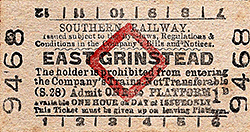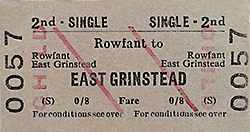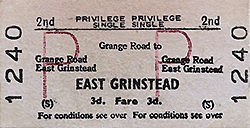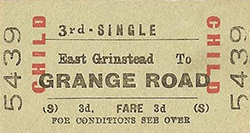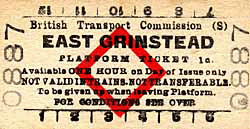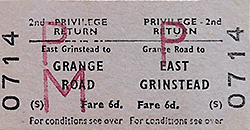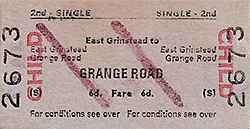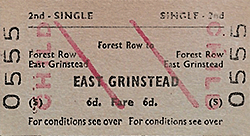
[Source:
Nick Catford]
East Grinstead High Level Station: Gallery 1 1860-c1905 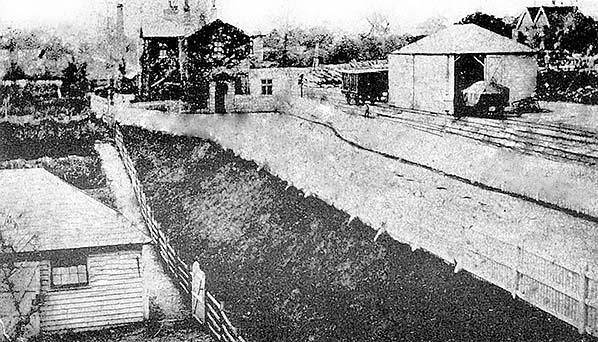 The first East Grinstead Station seen looking west in 1860. Compare this picture
with the picture of the original station building which is still standing.
 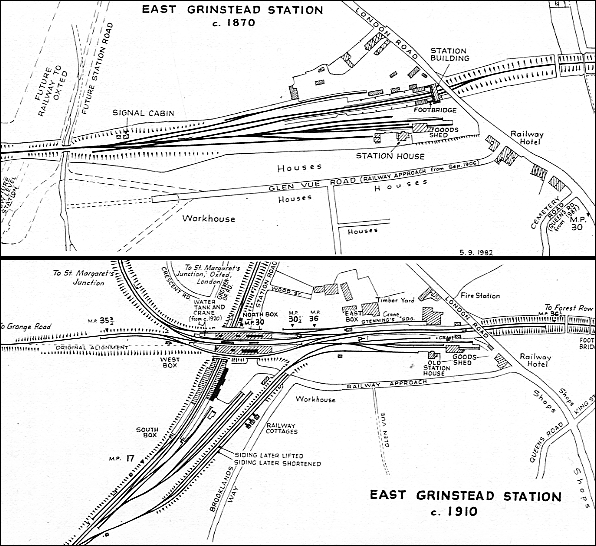
The top map shows the layout of East Grinstead Station in 1870 and the bottom map shows the layout in 1910 after the station was re-sited to the west.

1899 1:2,500 OS map clearly shows the layout of the High and Low Level stations and goods yards. St Margaret's Curve bends round to the north to join the Oxted line. The East and West signal boxes are seen at either end of the High Level station.
 The second East Grinstead station on what is thought to be opening day, 1 October 1866, facing east towards Forest Row. The street level building was accessed from, but was not on, London Road which crossed the railway on a skew bridge and this explains the almost tunnel-like bridge beneath and just beyond the building. The scene is generally rather untidy and quite why steps down to each platform were not incorporated into the station building, thereby dispensing with the need for a footbridge, is not known. The brick arch bridge in the background carried a footpath over the railway and a little further on, out of view around the curve, is the short 78 yard tunnel, known as East Grinstead No. 1 Tunnel, taking the railway beneath College Lane. As can be seen, the station was gas lit from the outset. East Grinstead gasworks was situated on Moat Road, to the north of the station.

The second East Grinstead station on what is thought to be opening day, 1 October 1866, facing east towards Forest Row. To avoid any confusion it is perhaps worth pointing out that this station would in due course be replaced by what became East Grinstead High Level further west, it being a matter of convenience to include this and the original terminus on the Disused Stations High Level pages. It would appear the locomotive crew is being handed the train staff by the stationmaster, suggesting the inaugural westbound train, although this procedure would have been carried out with all trains. The locomotive is a LB&SCR 2-4-0 and while its identity is by no means confirmed it is possibly No. 40, built in 1854 by Messrs. Sharp, Stewart and Company. The LB&SCR used a bewildering array of headcodes, with plain and marked discs, such as the crossed discs seen here, along with lamps. Those codes varied in accordance with daylight and after-dark hours, also whether or not the crew were in possession of a staff or ticket. Not much headcode information for the pre 1881 period is known although it is fairly obvious the code seen here was for Tunbridge Wells - Three Bridges or vice versa including points in between such as East Grinstead - Three Bridges

The uncluttered forecourt area in this undated scene is from the late nineteenth century. Of note is the tall gas light on the left with an access ladder not dissimilar to those found attached to signals. The light is set in small enclosed garden.
Photo from John Mann collection 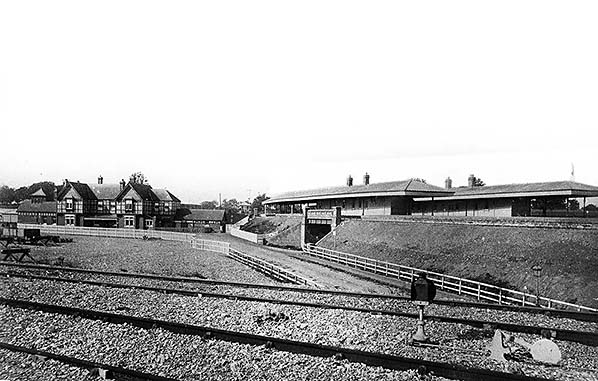
An interesting and good quality photograph taken in 1882, the year before the High Level section of the station opened. At this time the second station on the line from Three Bridges was in use. The tracks in the foreground were newly laid and connected to the Culver Junction and Lewes line. The tracks crossed Station Approach, running diagonally across the picture and once known as Glen Vue Road, on a bridge. Later, just one track crossed the bridge and the remainder, there were three in total, terminated on it. These were themselves later truncated, leaving just a single track crossing what had been reduced to a single span bridge. Note the ballast covering the sleepers; this was standard practice at the time but caused maintenance issues and was outlawed sometime around 1919. At centre far left can be seen further sidings, part of the goods yard, with at least one wagon present. Note the enclosed structures on the High Level platforms; by the time this part of the station closed these structures had been largely removed.
Photo from John Mann collection 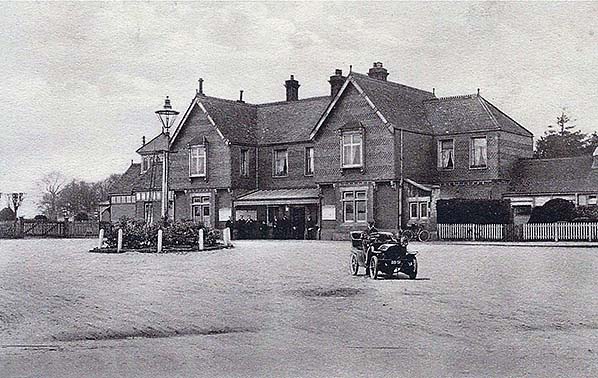 Another view of the forecourt, this time a little later. The motor car registration number dates from December 1903 so this would be the earliest date. Apart from the staff line-up, differences to the earlier scene include the appearance of more posterboards and a tidying up of the bushes at the north end of the building.
Photo from John Mann collection Click here for East Grinstead High Level: Gallery 2
1920s - Early 1960s
 Home
Page Home
Page
|

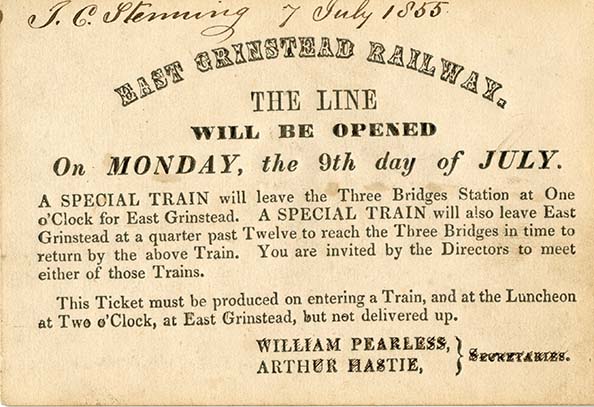
 BRIEF HISTORY OF THE THREE
BRIDGES - TUNBRIDGE WELLS WEST RAILWAY
BRIEF HISTORY OF THE THREE
BRIDGES - TUNBRIDGE WELLS WEST RAILWAY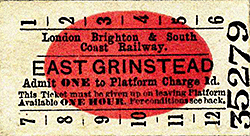 The EGG & TWR proposed to obtain powers to run over the BU & TWR line between Groombridge and Tunbridge Wells but before either line was opened the two companies were absorbed into the London Brighton & South Coast Railway in January 1865.
The EGG & TWR proposed to obtain powers to run over the BU & TWR line between Groombridge and Tunbridge Wells but before either line was opened the two companies were absorbed into the London Brighton & South Coast Railway in January 1865.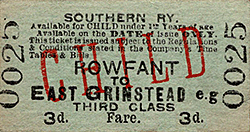 With the opening of the Lewes & East Grinstead Railway and the Croydon, Oxted and East Grinstead Railway in 1883 it was once again necessary to re-site East Grinstead Station. The two new lines approached the Three Bridges line at right angles from the north and south respectively. Because of the angle it was impossible to take the L & GR into the existing station so a new station was built a quarter of a mile to the west with two island platforms on the old line above and at right angles to a new station at the end on junction between the EGR and the CO & EGR with a sharply curving spur linking the two lines.
With the opening of the Lewes & East Grinstead Railway and the Croydon, Oxted and East Grinstead Railway in 1883 it was once again necessary to re-site East Grinstead Station. The two new lines approached the Three Bridges line at right angles from the north and south respectively. Because of the angle it was impossible to take the L & GR into the existing station so a new station was built a quarter of a mile to the west with two island platforms on the old line above and at right angles to a new station at the end on junction between the EGR and the CO & EGR with a sharply curving spur linking the two lines.
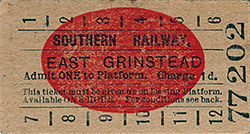 WW1 had little effect on the line and some new services were introduced following the formation of the Southern Railway in 1923. WW2 brought a reduction in services with the withdrawal of the rail motors. A government oil store was established at Rowfant bringing an increase in freight traffic. After the war some passenger services were reinstated but by 1950 both passenger and freight service were in decline and BR was considering the possible closure of the line between Three Bridges and Ashurst Junction in 1951 with passenger numbers at Hartfield in 1949 being only a quarter of those carried in 1923.
WW1 had little effect on the line and some new services were introduced following the formation of the Southern Railway in 1923. WW2 brought a reduction in services with the withdrawal of the rail motors. A government oil store was established at Rowfant bringing an increase in freight traffic. After the war some passenger services were reinstated but by 1950 both passenger and freight service were in decline and BR was considering the possible closure of the line between Three Bridges and Ashurst Junction in 1951 with passenger numbers at Hartfield in 1949 being only a quarter of those carried in 1923.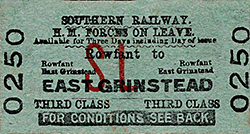 Despite strong local objections and a new timetable, Barbara Castle confirmed closure of the line between Three Bridges and Groombridge from 1st January 1967. Although originally proposed for closure the section between Groombridge and Tunbridge Wells West (West was added to the name in 1923) remained open.
Despite strong local objections and a new timetable, Barbara Castle confirmed closure of the line between Three Bridges and Groombridge from 1st January 1967. Although originally proposed for closure the section between Groombridge and Tunbridge Wells West (West was added to the name in 1923) remained open. 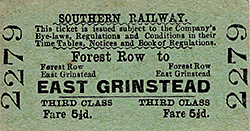 Grove Junction was removed the day after closure but the line from Eridge to Tunbridge Wells remained in use until 10th August 1985 when the depot was closed.
Grove Junction was removed the day after closure but the line from Eridge to Tunbridge Wells remained in use until 10th August 1985 when the depot was closed.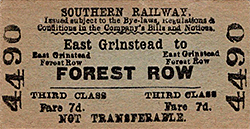 Further reading: Three Bridges to Tunbridge Wells by David
Gould Oakwood Press 1983
Further reading: Three Bridges to Tunbridge Wells by David
Gould Oakwood Press 1983
